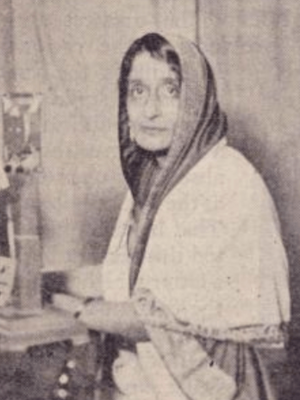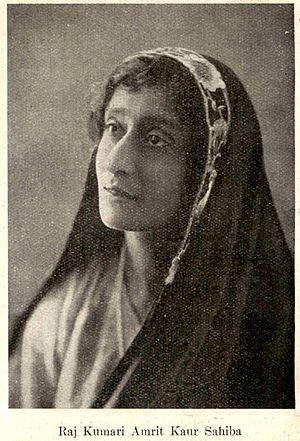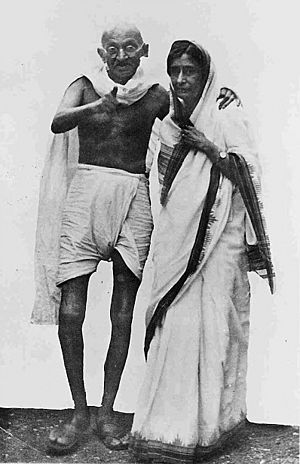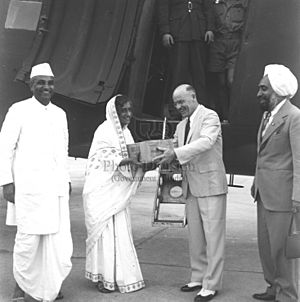Amrit Kaur facts for kids
Quick facts for kids
Dame
Amrit Kaur
|
|
|---|---|

Rajkumari Amrit Kaur, from a 1936 issue of The Indian Listener
|
|
| Born | 2 February 1887 |
| Died | 6 February 1964 (aged 75) |
| Organization | St John Ambulance, Tuberculosis Association, Indian Red Cross, All India Institute of Medical Sciences |
| Political party | Indian National Congress |
| Movement | Indian Independence movement |
| Minister of Health | |
| In office 16 August 1947 – 16 April 1957 |
|
| Prime Minister | Jawaharlal Nehru |
| Preceded by | Post established |
| Succeeded by | Sushila Nayyar |
| Personal details | |
| Parents | Harnam Singh Priscilla Golaknath |
Rajkumari Amrit Kaur (born February 2, 1887 – died February 6, 1964) was an important Indian activist and politician. She worked for India's freedom from British rule for a long time. After India became independent in 1947, she became the country's first Health Minister. She held this job until 1957.
Amrit Kaur also served as the Sports Minister and Urban Development Minister. She helped create the National Institute of Sports in Patiala. During her time as minister, she brought many improvements to healthcare in India. She is remembered for her work in health and for fighting for women's rights. Kaur was also a member of the Constituent Assembly of India. This group helped write the Constitution of India.
Contents
Life of Amrit Kaur
Amrit Kaur was born on February 2, 1887, in Lucknow, Uttar Pradesh, India. Her father was Raja Sir Harnam Singh Ahluwalia. He was the younger son of the Raja of Kapurthala. Her father became a Christian and married Priscilla, who was the daughter of a missionary. Amrit Kaur was their youngest child and only daughter. She grew up as a Protestant Christian.
Amrit Kaur went to school in England. She studied at Sherborne School For Girls in Dorset and then at Oxford University. After finishing her studies, she came back to India in 1918.
Amrit Kaur never married and did not have children. She passed away in New Delhi on February 6, 1964. Her personal papers are kept in the Archives at the Nehru Memorial Museum & Library in Delhi.
Amrit Kaur's Career
Working for India's Freedom
After returning to India, Amrit Kaur became very interested in the Indian independence movement. Her father knew many leaders of the Indian National Congress, like Gopal Krishna Gokhale. These leaders often visited their home.
Kaur was inspired by Mahatma Gandhi. She met him in Bombay in 1919. She worked as Gandhi's secretary for 16 years. Their letters to each other were later published in a book.
In 1919, British soldiers shot many peaceful protesters in Amritsar. This event was called the Jallianwala Bagh massacre. After this, Kaur strongly criticized British rule in India. She officially joined the Congress party. She actively worked for India's freedom.
She also worked for social reform. She was against the practice of purdah, which meant women had to cover themselves. She also fought against child marriage. She worked to end the devadasi system, where young girls were dedicated to temples.
In 1927, Kaur helped start the All India Women's Conference. She became its secretary in 1930 and president in 1933. She was put in jail by the British. This was because she took part in the Dandi March in 1930, led by Mahatma Gandhi. In 1934, Kaur went to live at Gandhi's ashram. She chose to live a simple life, even though she came from a wealthy family.
In 1937, she went on a special trip to Bannu as a representative of the Indian National Congress. The British authorities accused her of trying to cause rebellion and put her in prison.
The British government made her a member of the Advisory Board of Education. But she quit this job when she joined the Quit India Movement in 1942. She was arrested again for her actions during this time.
She strongly supported the idea that everyone should have the right to vote. She spoke to committees about voting rights and changes to India's government.
Kaur was the leader of the All India Women's Education Fund Association. She was also on the committee for Lady Irwin College in New Delhi. She represented India at UNESCO meetings in London (1945) and Paris (1946). She also served on the board of the All India Spinners' Association.
She worked hard to reduce illiteracy. She also tried to end child marriages and the purdah system, which were common in some Indian communities.
Member of the Constituent Assembly
After India became independent in August 1947, Amrit Kaur was chosen to be part of the Indian Constituent Assembly. This group was responsible for writing the Constitution of India. She also worked on smaller groups within the Assembly. These groups focused on basic rights and the rights of minority groups.
As a member, she supported having a Uniform Civil Code in India. This would mean the same laws for everyone, regardless of their religion. She also pushed for universal voting rights. She spoke against special treatment for women and discussed laws about protecting religious rights.
India's First Health Minister
After India gained independence, Amrit Kaur joined Jawaharlal Nehru's first Cabinet. She was the first woman to hold a Cabinet position in India. She served for ten years. In January 1949, she was honored with the title of Dame of the Order of Saint John.
She was given the job of Health Minister. In 1950, she was chosen to be the president of the World Health Assembly. As Health Minister, Kaur led a big effort to stop the spread of malaria in India. She also led campaigns to get rid of tuberculosis. She started the world's largest BCG vaccination program.
As Health Minister, Kaur was key in setting up the All India Institute of Medical Sciences (AIIMS) in New Delhi. She became its first president. She introduced a bill in Parliament in 1956 to create AIIMS. This was based on a recommendation from a national health survey. Kaur worked hard to raise money for AIIMS. She got help from countries like New Zealand, Australia, West Germany, Sweden, and the United States. She and her brother even gave their family home in Simla to be a holiday place for the staff and nurses of AIIMS.
Kaur also helped start the Indian Council of Child Welfare. She was the leader of the Indian Red Cross society for fourteen years. Under her leadership, the Indian Red Cross did important work in rural areas of India. She also served on boards that fought tuberculosis and leprosy. She started the Amrit Kaur College of Nursing and the National Sports Club of India.
The College of Nursing in New Delhi (started in 1946) was renamed the Rajkumari Amrit Kaur College of Nursing in her honor.
From 1957 until she passed away in 1964, she was a member of the Rajya Sabha (India's upper house of Parliament). She was also the president of the All-India Motor Transport Congress in Delhi from 1958 to 1963. Until her death, she continued to lead AIIMS, the Tuberculosis Association of India, and the St. John's Ambulance Corps. She also received the Rene Sand Memorial Award and was named TIME Magazine's Woman of the Year in 1947.
See also
 In Spanish: Rajkumari Amrit Kaur para niños
In Spanish: Rajkumari Amrit Kaur para niños




